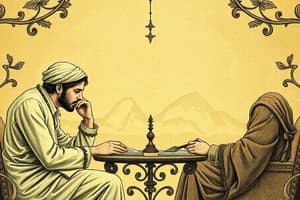Podcast
Questions and Answers
What molecule is regenerated at the end of the Krebs cycle?
What molecule is regenerated at the end of the Krebs cycle?
- Citrate
- Oxaloacetate (correct)
- FADH2
- NADH
The transition stage directly produces ATP.
The transition stage directly produces ATP.
False (B)
What is another name for oxidative phosphorylation?
What is another name for oxidative phosphorylation?
Electron Transport Chain (ETC)
The electron transport chain produces between ____ to ____ ATP per glucose molecule.
The electron transport chain produces between ____ to ____ ATP per glucose molecule.
Match the stage of cellular respiration with the corresponding ATP production:
Match the stage of cellular respiration with the corresponding ATP production:
Which of the following is a waste product of the Krebs cycle?
Which of the following is a waste product of the Krebs cycle?
The Krebs cycle is an anaerobic process.
The Krebs cycle is an anaerobic process.
What is the purpose of the electron transport chain (ETC)?
What is the purpose of the electron transport chain (ETC)?
In cellular respiration, glycolysis produces ____ ATP.
In cellular respiration, glycolysis produces ____ ATP.
What is the total ATP production per molecule of glucose in cellular respiration?
What is the total ATP production per molecule of glucose in cellular respiration?
The Electron Transport Chain is the same as Oxidative Phosphorylation.
The Electron Transport Chain is the same as Oxidative Phosphorylation.
What products are formed when citrate is the reactant?
What products are formed when citrate is the reactant?
During the Kerbs cycle, 3 ____ and 1 ____ are produced from each pyruvate.
During the Kerbs cycle, 3 ____ and 1 ____ are produced from each pyruvate.
What is being oxidized during the Kerbs cycle?
What is being oxidized during the Kerbs cycle?
The transition stage of cellular respiration requires oxygen to proceed.
The transition stage of cellular respiration requires oxygen to proceed.
What is the input of the transition stage?
What is the input of the transition stage?
The final ATP tally is ____ to ____ ATP.
The final ATP tally is ____ to ____ ATP.
What is the primary purpose of using electrons in the electron transport chain (ETC)?
What is the primary purpose of using electrons in the electron transport chain (ETC)?
The Krebs cycle produces more ATP than the electron transport chain.
The Krebs cycle produces more ATP than the electron transport chain.
Match the molecules related to Kerbs with the quantity produced:
Match the molecules related to Kerbs with the quantity produced:
Flashcards
Krebs cycle need oxygen?
Krebs cycle need oxygen?
Series of biochemical reactions that oxidizes molecules, producing energy. Requires oxygen because it is aerobic.
Oxidative Phosphorylation
Oxidative Phosphorylation
Also known as the Electron Transport Chain (ETC)
ATP produced by ETC?
ATP produced by ETC?
32 to 34 total ATP per glucose molecule.
Total ATP produced in cellular respiration?
Total ATP produced in cellular respiration?
Signup and view all the flashcards
Purpose of ETC?
Purpose of ETC?
Signup and view all the flashcards
ATP produced in Glycolysis?
ATP produced in Glycolysis?
Signup and view all the flashcards
ATP produced in Kreb's Cycle
ATP produced in Kreb's Cycle
Signup and view all the flashcards
Study Notes
- Game Theory mathematically formalizes strategic decision-making in multi-agent interactions.
- Game Theory assumes agents act rationally in their own best interests, with applications in economics, political science, computer science, and biology.
Prisoner's Dilemma
- Two suspects are arrested and cannot communicate, being offered deals by the police.
- If one confesses, they go free while the other gets 10 years.
- If both confess, they each get 5 years.
- If neither confesses, they each get 1 year.
Payoff Matrix Example
| Suspect B Confesses | Suspect B Stays Silent | |
|---|---|---|
| A Confesses | (-5, -5) | (0, -10) |
| A Stays Silent | (-10, 0) | (-1, -1) |
- The dilemma illustrates that individual rationality leads to both suspects confessing.
- This leads to a collectively irrational outcome where both are worse off than if they had stayed silent.
Algorithmic Game Theory
- Combines game theory and algorithm design.
- It addresses computational issues in game theory and uses game-theoretic ideas for better algorithm design.
- Key topics include computing equilibria, mechanism design, and the price of anarchy.
Nash Equilibrium
- Defined as a set of strategies where no player benefits from unilaterally changing their strategy.
- A strategy profile $s = (s_1, s_2,..., s_n)$ is a Nash equilibrium if for every player $i$ and every alternative strategy $s'i$,
$u_i(s_i, s{-i}) \geq u_i(s'i, s{-i})$
- $s_i$ is the strategy of player i
- $s_{-i}$ is the vector of strategies of all players except i
- $u_i$ is the utility function of player i.
Nash Equilibrium Example: Rock-Paper-Scissors
- Players use a mixed strategy, randomizing their actions.
- The Nash Equilibrium involves each player choosing each action with a probability of 1/3.
Mechanism Design
- Involves designing game rules to achieve desired outcomes despite players' selfish behavior.
- Examples include auction design to maximize revenue, and voting systems to elect the best candidate.
VCG (Vickrey-Clarke-Groves) Mechanism
- Designed to incentivize players to reveal their true preferences.
- It selects the outcome that maximizes the sum of the players' utilities, ensuring social welfare maximization.
Price of Anarchy (PoA)
- Measures the degradation of social welfare due to selfish behavior.
- $PoA = \frac{\text{Social Welfare in the Worst Nash Equilibrium}}{\text{Optimal Social Welfare}}$
- A higher PoA indicates greater inefficiency.
Braess's Paradox
- Shows that adding a road to a network can increase travel time for everyone.
- Selfish routing by drivers can result in an equilibrium worse than if some roads were closed.
Citric Acid Cycle
- Starts with 2 Citrate(p) and 2 Citrate(g), ends with 1 oxaloacetate(p) and 2 oxaloacetate(g)
- Oxidizers:
- 3 NAD+(p) 1 FAD(p) becomes 3 NADH(p) 1 FAD(p)
- 6 NAD+(g) 2 FAD(g) becomes 6 NADH(g) 2 FAD(g)
- Waste Products:
- 2 CO2(p)
- 4 CO2(g)
- Energy Production:
- 1 ATP(p)
- 2 ATP(g)
- Krebs cycle requires oxygen because it is aerobic.
Oxidative Phosphorylation
- Same as the Electron Transport Chain (ETC)
- 32 to 34 total ATP are produced at the end of the ETC per glucose molecule.
- 36-38 total ATP are produced per molecule of glucose in cellular respiration.
ATP per Stage of Cellular Respiration
- Glycolysis: 2 ATP
- Transition: 0 ATP
- Krebs Cycle: 2 ATP
- Electron Transport Chain: 32-34 ATP
- Total: 36-38 ATP
Purpose of ETC
- To make the most ATP without using cellular energy (ATP).
- To use electrons for energy.
Studying That Suits You
Use AI to generate personalized quizzes and flashcards to suit your learning preferences.




